How to Optimize an Amazon Listing
How many people shop online? Take a guess. 2.14 billion, and this number is on the rise. In 2023, people want quick, convenient, and stress-free shopping experiences, no questions asked. The e-commerce industry operates around this logic, which makes it so strikingly successful.
Amazon, in particular, drives swarms of sales each year. Why? It makes shopping fun, easy, and quick.
As an Amazon seller, you’re sitting on a gold mine, provided that you use your Amazon store wisely. Successful Amazon product listings can help you make enviable sales, expand your store, and kick-start impressive growth.
Need a hand? In this blog, we’ll cover the top Amazon FBA listing optimization strategies to help you hit the Amazonian ground running. We’ll also focus on the importance of Amazon listing keyword optimization.
Buckle up!
1. Keyword Research

Put yourself in your audience’s shoes for a second. If you’re looking for a product, you’ll enter a set of unique words and phrases in the Amazon search box. These are called keywords; they indicate user search intent.
If your product listing doesn’t feature the right keywords, you’ll lose your audience before you even get a chance to capture their attention. The goal is to turn as many eyes towards your listing as possible. A power-packed Amazon keyword research plan will help you check this box off the list.
Use a keyword tool that gives you a complete picture of what buyers are actively searching for on Amazon, specifically in your local industry. Once you start discovering the top-searched keywords, you’ll detect patterns that give you a better grasp of user search intent.
Amazon’s impressive keyword tool uses autocomplete to detect the most popular long-tail searches. Start incorporating these keywords into your listing for better visibility.
You can also perform manual keyword research. Type a variety of industry-specific words and phrases in the search box. Every word you write will fetch a set of drop-down suggestions. Use these to craft an actionable keyword plan that gives you the rankings and visibility you deserve.
Focus on:
- Short-Tail Keywords:Yield broad searches with extremely high search volume and competition. Since these keywords aren’t specific, they generally have lower conversion potential.
- Long-Tail Keywords:Hyper-specific keywords with low search volume and competition. Long-tail keywords are extremely specific and yield much higher conversions.
Use this guide to keep the difference in mind:
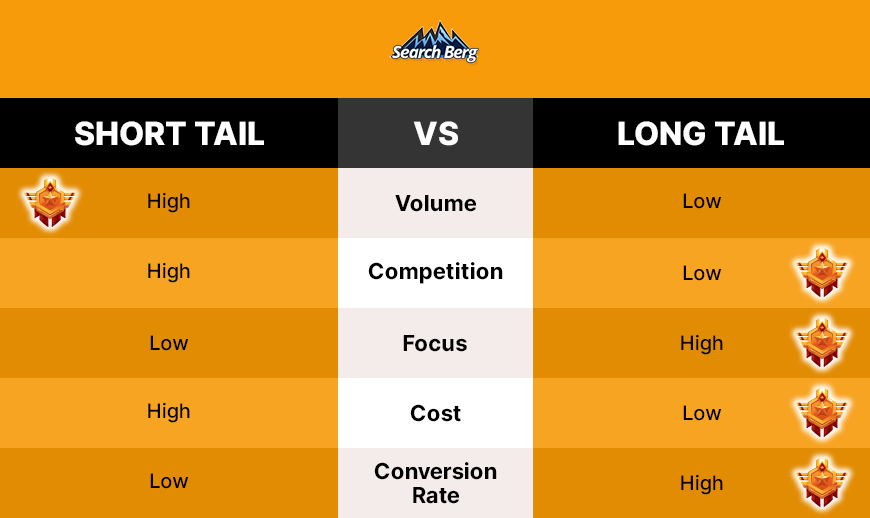
Both short-tail and long-tail keywords are equally important, but in different ways. Short-tail keywords are a bit more open-ended. Buyers aren’t exactly sure what they want, but they’re in the right ballpark. They explore the search results and decide based on the options available to them.
Short-term Amazon keywords could be “towels”, “frying pans”, “engagement rings”, etc. They’re simple and generic.
Customers who enter long-tail keywords are typically on the hunt for very specific products. These searches are more refined, precise, and often complex. These buyers know exactly what they want. Examples include “soft microfiber face towel for sensitive skin”, “non-stick granite PFOA-free 24 cm frying pan”, and “12 carat cushion cut rose gold engagement ring”.
See what we mean? So while you’re targeting people who just enter “frying pan” in the search bar, you’re also targeting informed buyers who have done their research and shortlisted the type of frying pan they want—down to a tee.
Your Amazon keyword research plan should change each week as product trends, demand, and consumption patterns evolve. For instance, if you sell engagement rings on Amazon, your keyword research plan will also include “Valentine’s Day” themed keywords leading up to February. Of course, these keywords will not make the cut during the rest of the year.
Special events, holidays, and occasions must be incorporated into your keyword plan. The more comprehensive and meticulous you are, the better.
Recommended Read: 11 Ways to Triple Your B2B E-Commerce Conversions
2. Product Title
Keyword research is half the trick. Once you’ve collected the most relevant and high-ranking keywords for each product, it’s time to incorporate them into your listing, starting with the product title.
First impressions always matter, especially when it comes to online products. The average human attention span has dropped to 8 seconds. If you don’t catch people’s attention within the first few seconds, you’ll fail to earn clicks.
The product title is your first opportunity to make a kickass impression on your audience. This is one of the primary fields used by Amazon to determine whether a product is relevant to the search terms. If you incorporate the right keywords into the title, your listings will rank higher on Amazon search result pages.
However, you need to keep a few things in mind. Your product title should always match the product name, i.e., the title written on the physical product itself. This is why products must be named carefully.
If you sell a fast charging block on Amazon and want to name it “The Mighty”, go with “The Mighty Fast Charging Block” instead. Why is this better? There’s more specificity. While “The Mighty” sounds pretty cool as a standalone product name, it can be anything: a big burger, a turbo generator, and so on. Specificity is very important.
Keep these caveats in mind as well:
- You’re working with a character limit. The title should fall between 60–80 characters. If it’s too short, it won’t give much away. And if it’s too long, it’ll be difficult to read, and you’ll lose people’s attention (keep the limitations of the human attention span in mind).
- Avoid using all caps. While the first letter of each word should be capitalized, prepositions, conjunctions, and articles (at, and, or, in, on, for, the, a, an, etc.) should be in lowercase.
- Avoid spelling out numbers; use numerals instead (e.g., “3” instead of “three”).
- Write an objective title. Avoid subjective descriptions, exaggerations, and promotional phrases like “bestseller”, “hot item”, “quality guaranteed”, etc.
- Always abbreviate measurements (cm, kg, etc.) and use “&” instead of “and”. If you fail to do this, your title will get too long and wordy.
- Avoid using decorative characters (~ ! * $ ? _ ~ { } # <> | * ; ^ ¬ ¦) and non-language ASCII characters (Æ, ©, or ®).Your product title should be professional and simple, not visually overwhelming.
There are many more guidelines you must follow. Explore Amazon Seller Central’s product title requirements to ensure you’re not making any mistakes. Optimization and compliance will help you rank higher for relevant searches and avoid search suppression. How can you get things right? Here’s an excellent example:
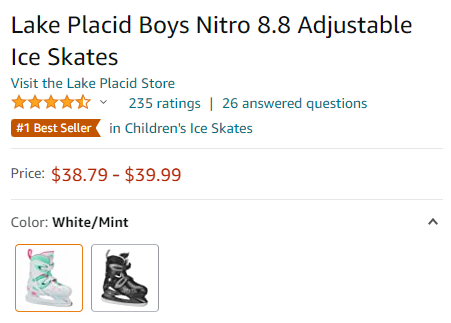
The title provides the right amount of information without going overboard. The model name has been specified. We also know that the skates are adjustable. While your product title should start with the unique name of your product, the product itself should be mentioned towards the end.
Instead of titling this product “Lake Placid Boys Nitro 8.8”, the seller added “Ice Skates” at the end. When you keep these details in mind, you’ll be able to optimize your Amazon listing like a seasoned pro.
3. Product Features
There’s a lot that you will not be able to mention in the title. Save some of this information for the product features (the rest will be added to the description box; we’ll get to that in a bit). The Amazon product feature box is easily one of the most pivotal components of your listing. An engaging, information-packed, easy-to-read, professional, and well-structured feature box is your golden ticket to high rankings and great sales.
If a buyer doesn’t like your product just from the title and the image, a kickass overview of the features can help turn things around. Many sellers make the mistake of making their product feature box too creative and informal. Let’s examine why this is a faux pas.
For starters, you’re not writing a blog. You’re highlighting the features of a product, i.e., shedding light on its properties. This is not the time to use flowery adjectives or explain how your product will change people’s lives. Instead, it’s the perfect opportunity to help people understand what your product has to offer so they can make a decision on their own.
The decision-making power ultimately lies in your audience’s hands. If you snatch this from them and forcefully compliment and market your product, you’ll sound too salesy and drive people away.
Let’s cut to the chase; what should you do? Here’s a great example of a product feature box:
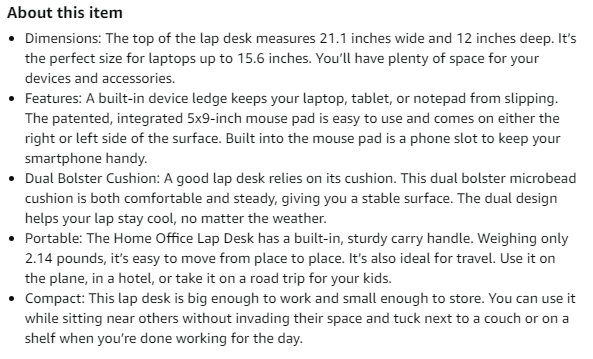
Packed with information, this box gives people a complete overview of what the product has to offer. By the end of the features, buyers should have little to no further questions. It’s important to note that while your product feature box should provide ample information, it should still be readable. Avoid big chunks of text and break the content down as much as possible.
Bullet points will help you maximize readability without compromising on the amount of information you provide. Like the title, the feature box should also be factual. Highlight salient features, avoid exaggeration, and use keywords in a clever and undetectable manner.
Here’s another great example:
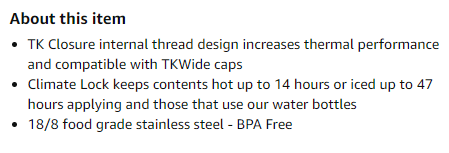
Short, sweet, and simple, this feature box tells you everything you need to know about the product. It has also been optimized with short-tail keywords like “stainless steel” and “BPA free”. Before finalizing the product feature box for your listing, turn to your top competitors for help. Take a closer look at their top-ranking product features.
- How much detail have they provided?
- Which points have they covered?
- Is there something new they added that you didn’t think of before?
Remember, these products are ranking among the top search results for a reason: they’re spectacularly optimized. As you take inspiration from their features, you’ll be able to craft yours accordingly.
This little trick will help you understand what works in your industry. Each industry, product, and audience is different. While you need to provide more information for a laptop, you don’t need to be as comprehensive for a set of color pencils. Keep these nuances in mind to write masterful product features.
Seller Tip: If you want to write an even smarter feature box, create categories. This is a great way to ensure that your product features are easy on the eyes. Buyers will not be forced to scan chunky paragraphs or worry about long sentences. Instead, they’ll get bite-sized information that gives pretty much everything away in a more organized manner.
Here’s an example:
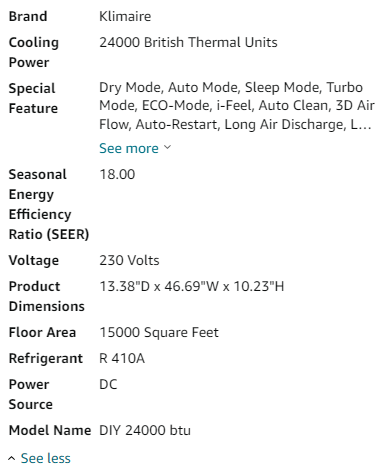
The information is neatly compartmentalized, which makes it extremely easy to scan. Buyers don’t have to invest a lot of effort in finding relevant details; everything’s out there in plain sight.
The product feature box is the first section people jump to once they open a product page. When you provide all the required information without messing with the format’s specificity, you’ll turn curious visitors into loyal buyers.
4. Product Description
The product description comes much later. This is where you get a chance to go all out as far as the provision of information goes.
Since the product feature box is still concise, you will not be able to mention everything. The product description has no limit; you can cover pretty much anything and everything. This doesn’t mean that your product description should be 5,000 words long. Use your words carefully and sum things up as much as possible.
While you can opt for a longer word count, it’s still better to keep things on the shorter side. People don’t have time to read through chunks of text, no matter how useful they may be. Here’s what a good product description looks like:
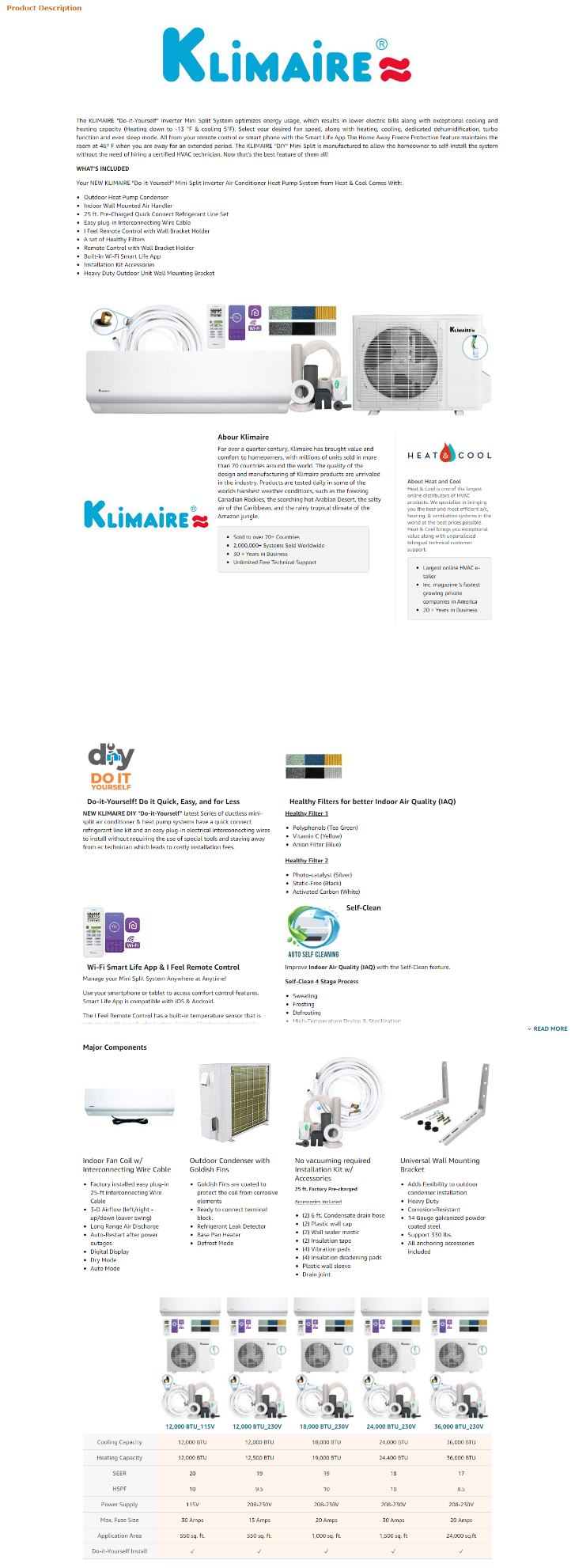
Pretty comprehensive, right? While this description is as descriptive as it gets, it’s not overwhelming. Why? Because the seller has cleverly supplemented the text with visuals.
We’ll cover the importance of good Amazon listing visuality in the next section, but it begs to be touched upon right now. Since the description covers more detail, it must include clean visuals that break the textual monotony and add some excitement back to the content.
In this case, the seller has used a variety of graphics to help buyers understand the product variations and features in detail. Visual content will ultimately help you explain your product in ways that words can’t. It’ll also make your product listing more aesthetically appealing. If you strictly provide text, people will get bored and head towards the nearest exit.
Optimize your product description with images, illustrations, animations (if required), and other graphics as you deem fit.
5. Product Images & Videos
Let’s get to the most visually exciting part of your Amazon listing: the visual content. High-quality, relevant, and original images and videos are your golden ticket to converting a wider chunk of your audience.
Sure, providing textual information is very important. However, at the end of the day, people want to see what your product looks like. Excellent photography and videography will go a long way in helping you enjoy stellar sales.
For starters, make sure you use 100% original images. If you don’t have a collection of original product images yet, create one. Use professional lighting, experiment with different angles, play up the background, hire professional models, and use high-quality props.
If you want to go the extra mile, provide a 360-degree view of your product. This is a great way to help people understand what the product will look like once it lands in their hands.
Your product page should include at least six images and one video. The photos should appeal to your target audience and compel them to make a purchase. Here’s a power-packed example:
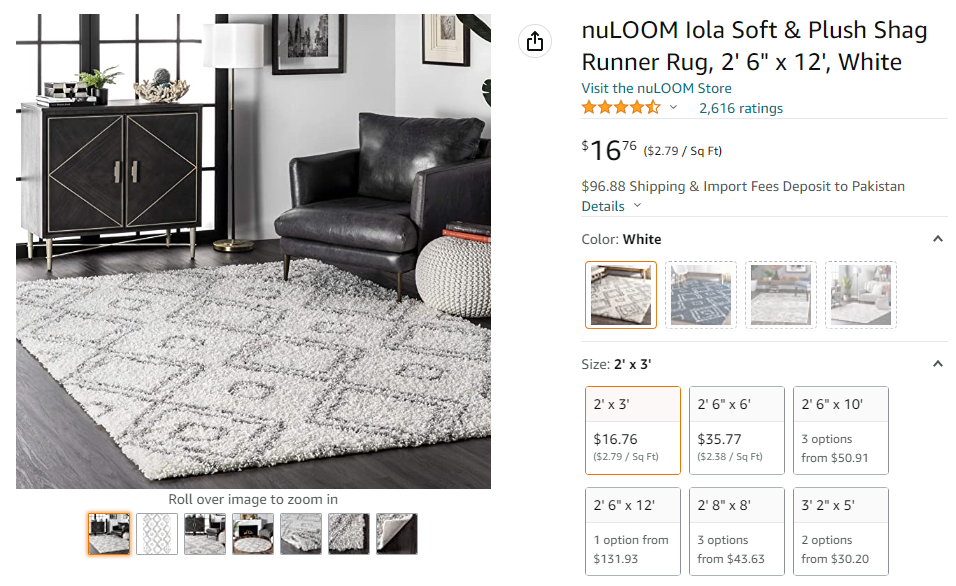
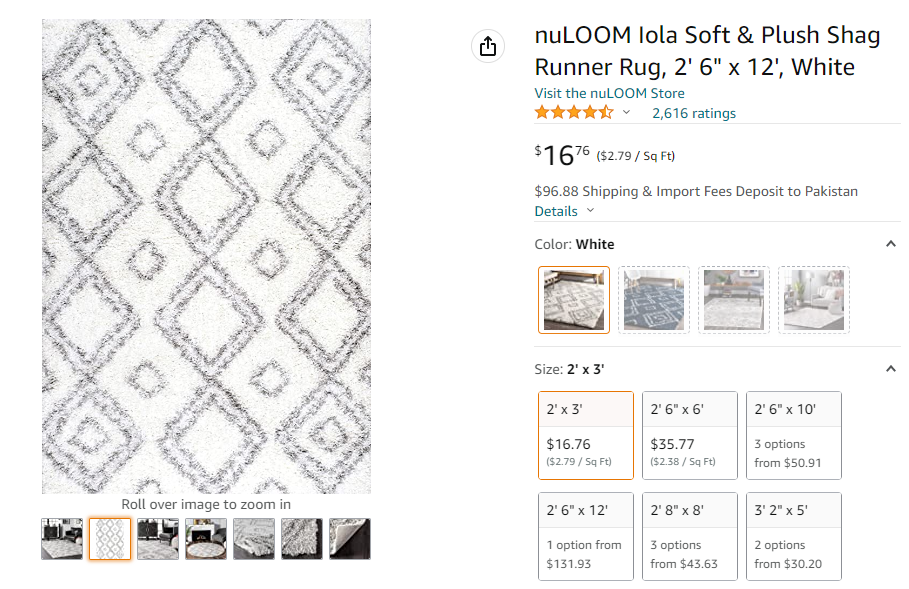
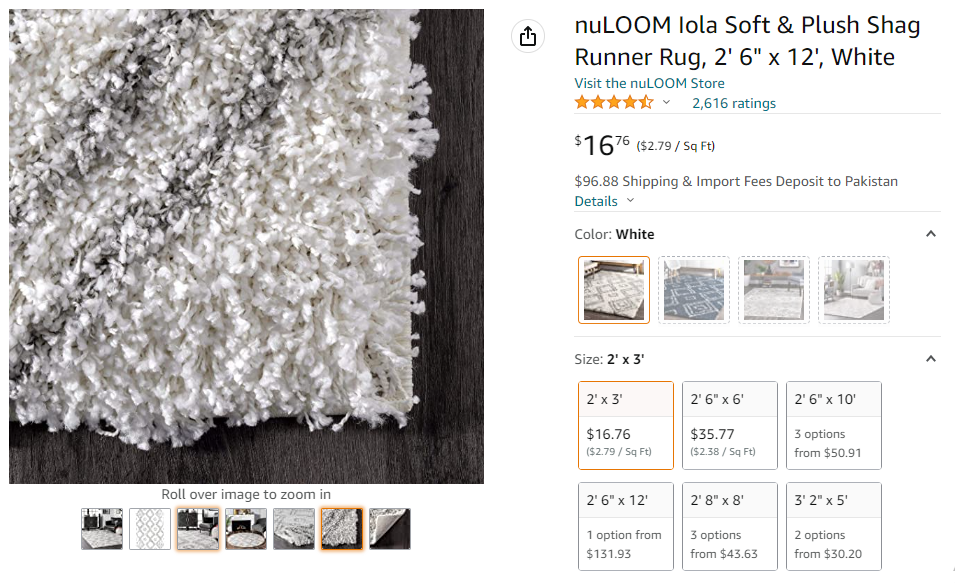
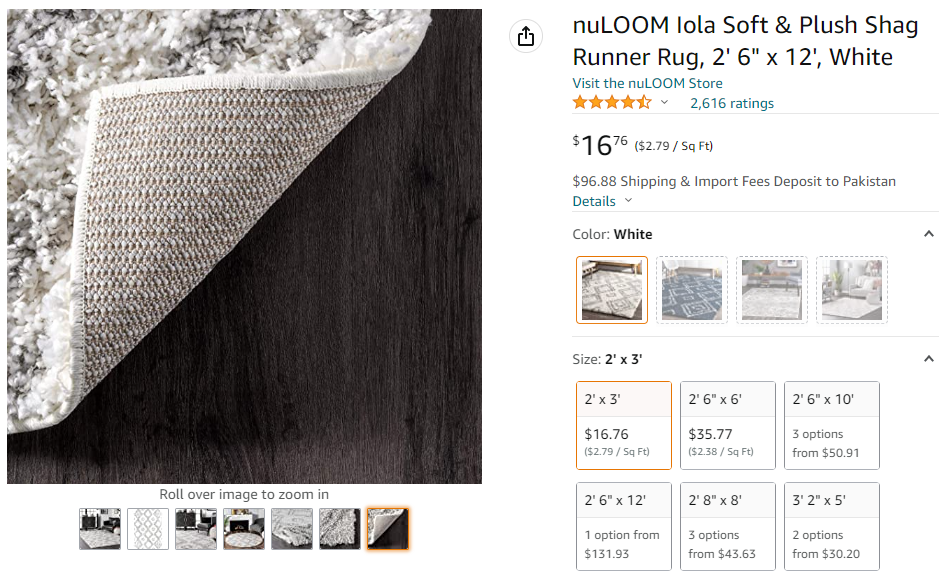
These are just a handful of the many, many pictures provided. The best part? You can see the rug from different angles and in different settings.
The first picture gives you an idea of what the rug would look like in your space. The second picture is a classic white background shot without any embellishments. The third photo gives you a close-up of the rug so you can see the texture up close. And the fourth picture shows the backside of the rug.
There’s a lot more where this comes from, and nothing is left to the imagination. This listing is further supplemented with a series of videos:

Now, you can’t just leave it at that. Make sure your images meet Amazon Seller Central’s product image requirements. You can also use the Amazon Seller App to optimize your photos and videos.
Amazon’s A+ Content SEO tool will also come in handy. As a tool designed to help sellers build and grow their stores, A+ Content (previously known as Enhanced Brand Content) allows you to describe product features in a more creative and unique way. Add a brand story, use enhanced images, and select strategic text placements to enjoy a higher conversion rate, increased traffic, and sweeter sales.
The Manage Your Experiments tool is another cool feature that lets you A/B test images, titles, and other parts of your listing to understand what performs better and use it to your advantage. Make sure you use these tools to squeeze the most juice out of your Amazon listing!
Let’s Fire Up the Amazon Arsenal!
In this blog, we walked you through the top Amazon FBA listing optimization strategies. Now that you have an A–Z understanding of how to optimize an Amazon listing, it’s showtime.
We won’t leave you in the lurch. At Search Berg, we provide professional Amazon listing optimization services to help you earn higher rankings, impressive traffic, and enviable revenue.
Our team starts by understanding each store’s unique industry, audience, requirements, and goals. Using this insight, we rework your Amazon store and listings to build a wider audience and maximize conversions.
Explore our pricing options and select the right plan accordingly. We offer free consultations, so you don’t have to worry about any commitments. Understand what we can do for you and make the right call for your store.
Let’s fire up the Amazon arsenal; we’re ready when you are!











